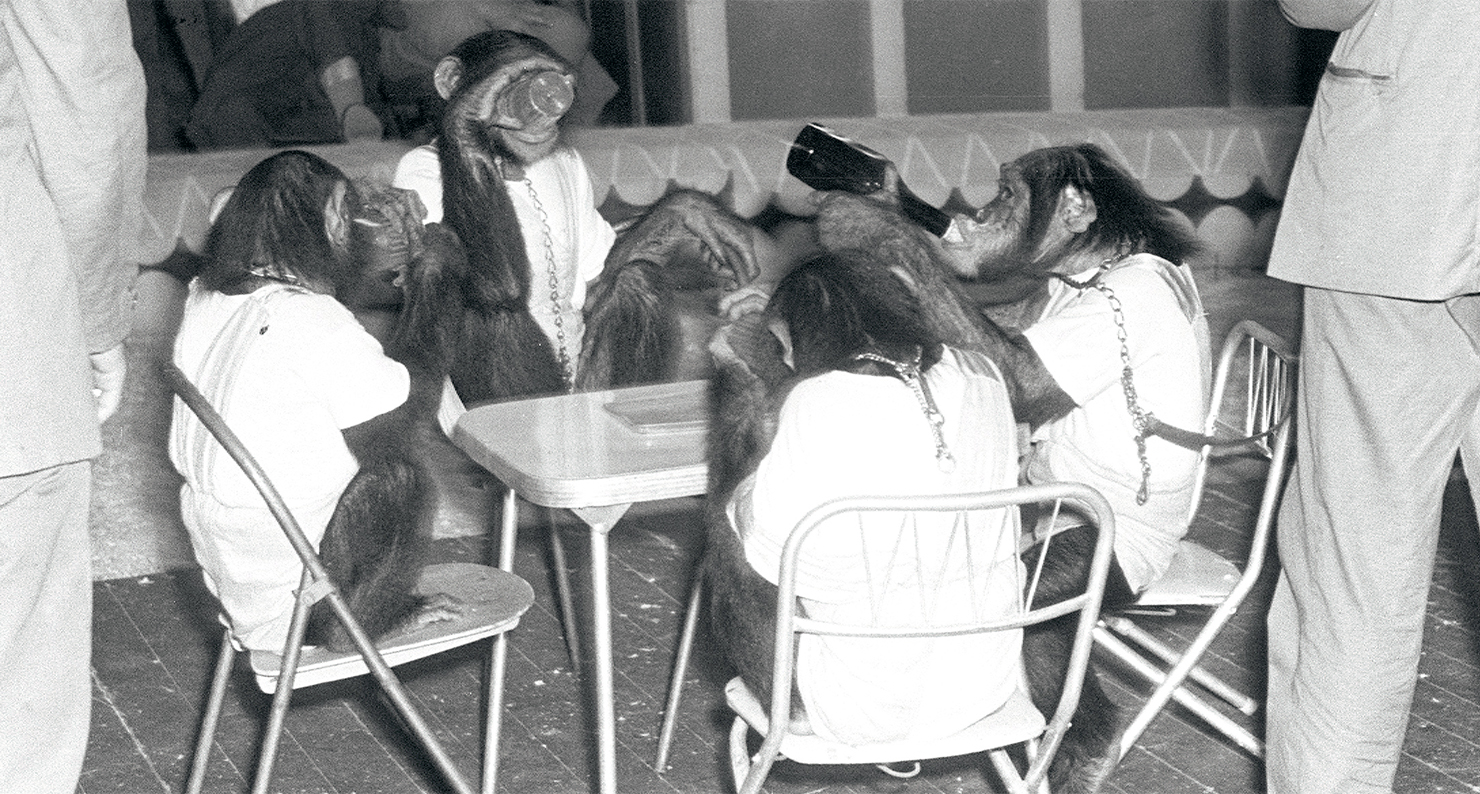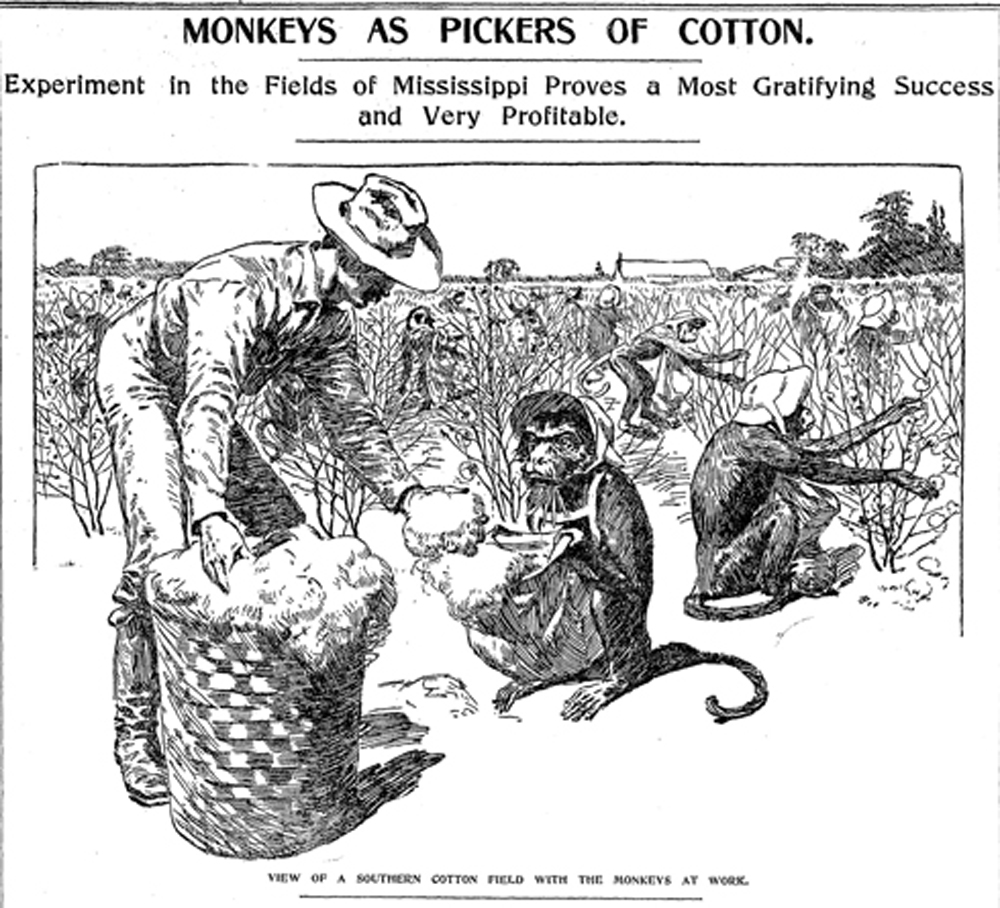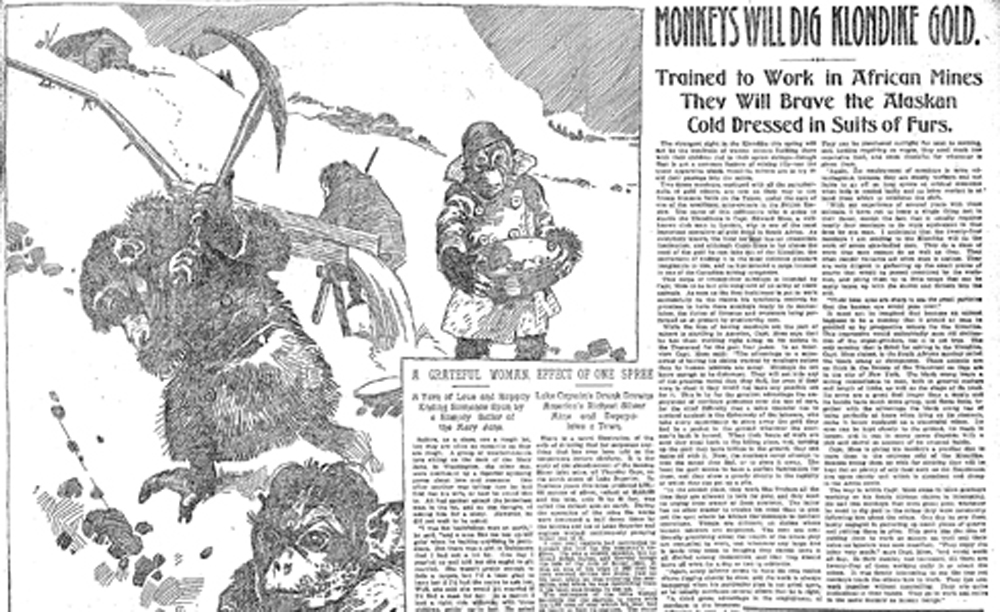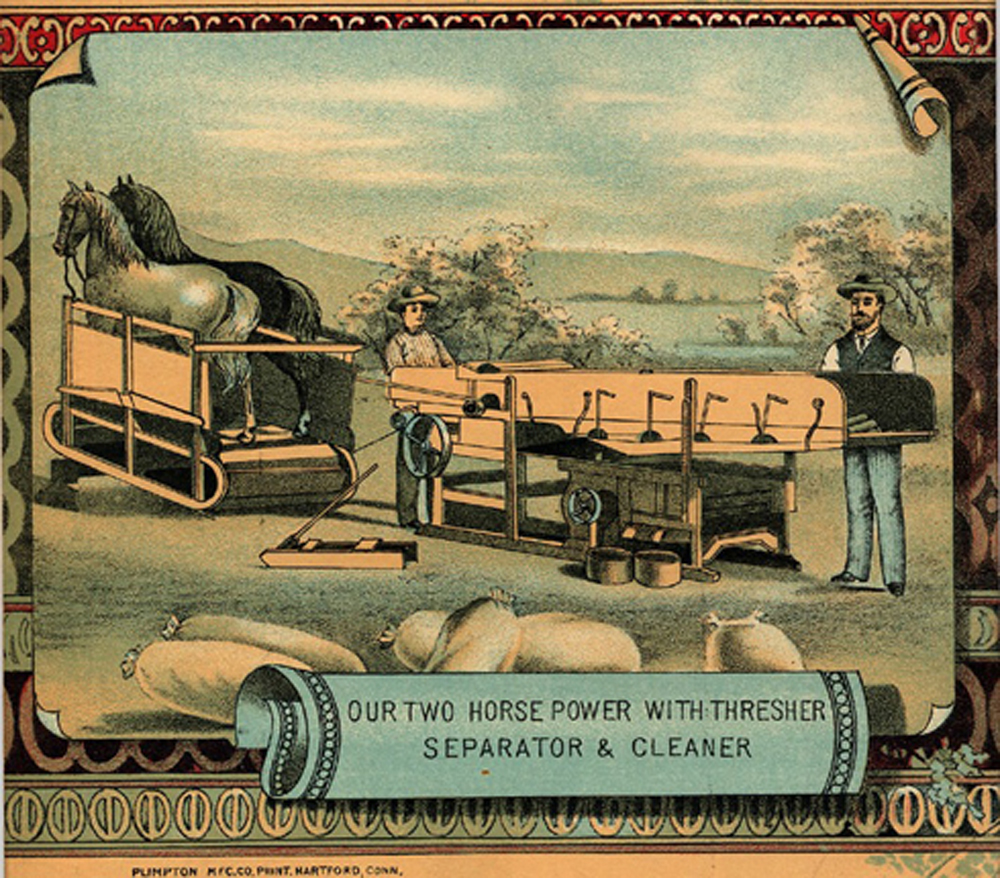
Circus at the Slovenian Military Academy, Maribor, Slovenia, 1961. Photograph by Jože Gal.
On November 11, 1960, a worker named Bobby clocked in at the Houston-area factory of the Superior Furniture Manufacturing Co., pressed a button on a bedding machine, and set about wrapping the legs of the company’s new Abba Dabba Lounge Chair before placing it in a shipping box. After a while he knocked off to take a break for a favorite snack: bananas.
But that was to be expected—because Bobby was a chimpanzee.
chimps given jobs at furniture plant papers roared that week, and it was true: joined by his simian co-workers Budgie and Fudgie, Bobby the chimp had cavorted around Superior Furniture in front of fifty journalists and photographers. Nearly as many members of the Upholsterers’ Union Local 250 stood by, dubiously observing manager Ben Friedman’s great experiment of placing chimpanzee workers in factory jobs. His motives, Friedman insisted, were entirely humanitarian.
“A couple of years ago I watched a movie showing humans drearily working on a conveyor belt, putting one box into another,” he explained to reporters. “They looked miserable.”
The event produced a photo spread in LIFE magazine—and netted Friedman a seven-page letter from the Upholsterers International Union, drolly demanding insurance and pension benefits for Bobby, Budgie, and Fudgie. “Your contract calls for reimbursement of pay in case of jury service, which raises special problems,” the notice added. But the chimps had turned in a notably lackluster performance in their one day on the job. They only managed about ninety minutes of work and slowed down the factory; it probably didn’t help that Bobby, as one reporter wrote, “did handsprings and jumped up and down on a conveyor belt.”
If the press suspected a publicity stunt, they were right—and it wasn’t entirely for the furniture company. As it happened, “I wrote a novel about this type of situation,” Friedman eagerly told them, “where a whole group of chimps were used in a factory...”
Friedman’s manuscript never found a publisher, but someone else’s did: G.K. Wilkinson’s 1962 novel The Monkeys. It imagined a dour French civil servant, Tastarin, returning from Africa to inherit an olive orchard near Marseilles. Finding labor too expensive, he brings four chimpanzees to do the picking, an act that sends the local Communist party into a frenzy and leaves the village slathered with graffiti: colonialism uses slave labor and monkeys go home.
A chimpanzee is actually an ape, but let it pass—Wilkinson’s target was neither apes nor monkeys, but people. Published just months after the end of the France’s disastrous Algerian War, amid the demographic shock of one million North African refugees pouring into France, The Monkeys is an allegory of colonialism returning to haunt the mother country—one even blunter than Pierre Boulle’s 1963 science fiction novel La planète des singes and its 1968 film adaptation, The Planet of the Apes.
Not that everyone noticed. Wilkinson’s book was, improbably, adapted by the Walt Disney Company into a 1967 movie, Monkeys Go Home! Disney kept the premise, the French setting, and a romantic subplot—but not the corrosive dialogue in which a Communist accuses the protagonist, “You n—— drivers are all alike, once you’ve had slaves to abuse you can’t give it up.”
Disney and Superior Furniture Manufacturing alike had tapped into a long mythology of monkey labor, one that stretched back to at least 1772. It was then that John Coakley Lettsome—a British physician, abolitionist, and friend of Benjamin Franklin—claimed that Chinese tea harvesters had “monkeys to assist them.” The Chinese, another account claimed, “mock, and irritate [the monkeys], till the animals, to revenge themselves, break off the branches, and shower them down on their insulters.” Enraged monkeys splintering tea-bushes is not exactly sustainable farming, but the explanation circulated widely for the next century, receiving an incalculable boost when it was quoted under the Encyclopedia Britannica’s 1797 entry for “Tea.”
Monkey-harvesters soon even acquired the appearance of an ancient lineage. Among the waves of discoveries of Egyptian artifacts in Beni Hasan in the nineteenth century, one wall painting in the c. 1900 bc tomb of Khnumhotep showed a fig harvest where, as Sir John Gardner Wilkinson put it in 1837, “Monkies appear to have been trained to assist in gathering the fruit.” It’s a charming explanation that some books repeat even today, and only slightly spoiled when one closely examines the tomb-painting: the monkeys aren’t handing over the fruit at all; they’re greedily stuffing figs into their own mouths.
Harvesting was a slave’s work in the American South, where in 1850 over ninety percent of the cotton harvest came from slave plantations, a crop which in turn accounted for roughly half of all U.S. exports. Yet the notion of monkey labor anticipated a question that would be born distinctly of the Industrial Revolution: are certain kinds of work below humanity?
A remarkable meditation upon the issue can be found in an anonymous Atlantic Monthly essay, “What Are We Going to Make?,” published in June 1858. Little known today, it posits the incipient abolition of slavery—not by war, but by mechanical force. “[Given] the fact a pound of carbon costs less than a pound of corn, and must cost less for at least a thousand years,” it theorizes, “chattelism of man will cease in another generation, and the next century will not dawn on a human slave.” With such power, the writer prophesizes, “an iron slave, the illustrious Man Friday of our modern civilization... shall make the humans all masters, from being nearly all slaves.”
For readers in 1858, though, the essay begged a more immediate question: what was to be done about the Southern slave? Within a month, a letter purporting to be from an Atlantic subscriber in Louisiana was circulating in newspapers across the country, claiming that “a feller who lives not far from here” had already tried to render slavery moot by picking cotton through a simpler expedient: monkeys.
One monkey would pick as much as a n——, and one n—— could oversee 10 monkeys. The monkeys was got and the trial was made… The only mistake about it was, instead of one n—— managing 10 monkeys it took 10 n——s to manage one monkey; so he has giv up experimentin and sticks to his old way of gatherin his crop.
It’s painful reading, but to readers at the time the humor was obvious: the letter’s spelling was the stock in trade of Southern-dialect satirists, right down to its final jab at the Boston-based Atlantic: “I think some of your articles is rather tu hifalutin on abolishen subjects.”

By Reconstruction, the uncomfortable satire curdled into outright racism. Weeks after the end of the war, a letter-writer to the Syracuse Daily Courier and Union repeated the monkey story as factual, and compared the use of regiments of African-Americans in the Union Army to the management of troublesome monkeys: “Will not the above clipping be the result of the employing of n—— soldiers?”
Thus began in earnest one of the most weirdly persistent hoaxes of nineteenth century America, one less concerned with the fundamental rights of man than the efficiencies of the market. In 1867, the tale was recycled into a first-person narrative in the Galveston News, complete with a rueful coda by its anonymous source—“My monkey speculation has thrown me behind six weeks in cotton picking”—which was then picked up and reprinted two weeks later by the New York Times. The rumor was again cited in 1883 in a testimony to the U.S. Senate Labor Committee, with the legendary monkey project now set in South Carolina, as well as in widely trumpeted claims of a huge monkey project in Smedes, Mississippi.
Sometimes the threat of simian replacement workers played upon growing labor fears a little too well, as when newspapers reported in 1887 that Kentucky grower James Parkes had trained monkeys as hemp harvesters. The timing was auspicious: the country was reeling from the nationwide May Day Strike of 1886, whose demands for an eight-hour work day climaxed with the Haymarket Massacre in Chicago.
A year after this violence, the reaction to the monkey tale was swift and scathing: a New York Times editorial headlined scab monkeys only half jokingly warned, “All the objections…urged against cheap Chinese labor apply with tenfold force to the case of the monkey…The monkey is and must be a scab, hopeless and irreclaimable.” Parkes had to resort to running notices denying that he owned either hemp fields or monkeys, in part due to suggestions like that made by the Times.
“They should hang these seven scab monkeys,” the paper had thundered, “with their own hemp.”

The ideal beast of burden has little in common with the monkey. In “What Are We Going to Make?” the Atlantic had already pondered the volatility of the “iron slave,” a mechanical beast that might, like the monkey, grow too dangerous to control. “Will not our artificial slave be more liable to insurrection?” they wondered in 1858. “Can we ever trust him as we trust ourselves, or our humble friends, the horse or the ox?”
In fact, we still do rely on our humble animal friends, whether they want befriending or not. And we rely on them in subtly different ways—as passive, active, or skilled labor. Lab animals and livestock can suffer or die for our own betterment; most of us will consume humanely tested or killed products if we feel the suffering brings a personal or societal benefit. Such passive labor is largely hidden today—we use it, but we don’t see or care to think much upon it.
But active animal labor was once a familiar sight indeed. While today we think of the nineteenth century as the Steam Age, one could almost as reasonably call it the Horse Age. In the last decade of the nineteenth century, Philadelphia was the home to some 50,000 horses, or about 400 per square mile, and Milwaukee’s equine density was nearly double that. In New York City, 12,000 horses were employed by streetcar services alone.
Railways were among the most enthusiastic users of horses; it was the perfect “last mile” motor. While steam engines achieved superhuman feats of endurance and strength—pumping out mines, say, or driving locomotives—most everyday needs required much less power, using instead what mechanics term “a fractional motor.” Until the rise of electric and gas motors in the twentieth century, horses were everything the steam engine was not: portable, able to start and stop quickly, and cheap to run. As historian Ana Norton Greene explains in her history of urban horse-power, “they are essentially biomechanical engines.” Blessed (or perhaps cursed) with an almost piston-like physiognomy, horses had fuel-to-energy efficiencies far in excess of early steam engines.
The horse was the beating heart of the Steam Age, not just in city streetcars or as trotters for country gentleman, but also generating power by working in teams on treadmills, or turning in endless circles against capstan wheels. There were horse-powered ferryboats; horse-powered hay balers and cotton-gins; even horse-powered chocolate factories. For its first few years, Manhattan’s municipal water system was powered by horses turning a pump wheel. The work did not benefit the horses much: some retired animals continued to circle compulsively.

But animals are capable of more than brute force; some possess the intelligence to learn skilled tasks. “Intelligence” is a notoriously slippery concept; for all the heartwarming stories of animal sagacity that we cling to anecdotally, most perform indifferently when subjected to the pithy definition of intelligence that inventor Charles Babbage formulated in 1840. “Intelligence,” he wrote, “would be measured by the capacity for anticipation.”
By Babbage’s standard, animals fare poorly. One 2001 review of anticipation studies in chimpanzees found “only moderate evidence” for foresight; many other animals have memories that are too short even to meet that standard. But a fairer modern standard might be intelligence (the ability to complete a task) versus cognition (the ability to infer causes, relations, and generalize from them). We then find that many animals are intelligent indeed—dolphins, for instance. Thanks to their trainability and impressive recognition capabilities, the U.S. Navy deployed dolphins to spot mines in the Persian Gulf; indeed, during the 1991 Gulf War, it almost looked like U.S. and former Soviet dolphins would square off on opposite sides.
But like monkeys, dolphins also bear a wildly outsized mythology. Hailed by researcher John Lilly as gentler, flippered versions of our most charming selves—a characterization one dolphin researcher mocked as “hobbits of the sea”—for a time it seemed as if dolphins would employ their famously large brains and their significant vocalization to communicate with humans. Alas, their chattering appears to be less of a language than an identification call. “The ability of dolphins to communicate,” as one cognitive psychologist puts it crushingly, “may be little greater than characteristic self-identifying bark of a dog.”
The difference is a key one. Dolphins are intelligent, but language bolsters human cognition. Without language, non-human users do not lend tools, use meta-tools to make tools, or share abstract causal ideas to make successive refinement to tools. The limits of intelligence without causality can become quickly apparent, as an elegant 2001 experiment by researcher Bruce Hood illustrates. He gave his monkeys a simple task: catch a piece of candy from a clear plastic tube. They excel at that. But put a bend in the tube, in full sight of the monkey, and they will keep expecting the candy to fall straight down. Human preschoolers will predict where the candy falls, but the monkey never catches on; thanks to a basic “gravity bias,” it won’t comprehend something as simple as an angled tube.
Animals are deeply and immediately practical. If an illogical series of actions produces a reward, a chimpanzee will stick with that. It knows what works, but perhaps not why. It is unlikely and perhaps even incapable of thinking through the motives behind that reward, or what the activity may lead to in time. It is intelligent, but it does not cogitate much.
And cognition is an advantage that humans can ruthlessly exploit. During the Second World War, the Soviet Union resorted to training dogs to wear explosives that would detonate when they ran up to German tanks. It is unclear whether the “anti-tank dog” program succeeded, except perhaps at being horrifying. But that disgust is instructive: animals are killed all the time in war, yet we cringe at sending one to obliterate itself, oblivious to any understanding or possibility of consent. We cannot help but view it as creatures who dounderstand the motive and causation of a suicide vest.
Training an animal to performed skilled work that results in certain death is also a shocking inversion of the rewards used in training them to a task. It feels remarkably manipulative and unfair—or at least it does to our cognitive selves. As one primate researcher points out, “non-human primates, apes included, are not very good at solving fairness problems,” while humans are have an inborn capacity to recognize inequality. Just as humans have the cognitive advantages that allow them to lead animals to unseen slaughter, so we also have the gift of feeling bad about it.
Maybe that’s what creates an especially strong sense of discomfort about monkey labor. Unlike a horse or dog or even a crude robot, a monkey is capable of intricate work requiring discernment and fine motor skills; but unlike humans, it still appears to undertake them with little causality or foresight—without meaning. Monkey business carries the special horror of absolute enslavement: for what else can it mean to have enough intelligence to perform a human task, but not enough to see beyond it?
There’s another problem with employing a chimp in a furniture factory, which is that after he arranges and packages your recliner, he might tear your face off.
If simian labor always had a larger mythical than practical role, it’s not least because chimps in particular are harder to control than a human. As notorious as one chimpanzee became for mutilating a Connecticut woman in 2009, they're capable of worse; seven years earlier, one of Jane Goodall's chimp subjects killed a Tanzanian toddler. Still, it's not hard to see why chimps are the simian of choice for hoaxers; as the most uncannily human of animals, the narcissistic temptation is to use them like a funhouse mirror, a clownish and harmless reflection of ourselves. And they are some kind of a reflection—chimps are our closest genetic relatives and the most sophisticated non-human tool users. But if in our fellow simians we desire to find ourselves, we will always be disappointed.
Some still try. The highest profile modern effort is Helping Hands, a Boston-based program that matches trained capuchin monkeys to assist quadriplegics. The program, founded in 1979 by a young protégé of behavioral psychologist B.F. Skinner, has placed over 150 monkeys nationwide to help comb their owners’ hair, fetch food, and clean spills. Inevitably, it seems, Disney stepped in: for a time, the program’s monkeys were raised in the now-abandoned Discovery Island zoo at Disney World.
It was Skinner himself who suggested using capuchins; weighing in at under ten pounds, they’re far more manageable than two-hundred pound chimps. They’re also known among researchers as having some of the best impulse control among monkeys; it has been theorized that, coming from a food-rich environment in South America, capuchins developed the ability to ignore food when more pressing or interesting tasks are in front of them.
Even so, the program is opposed by both the ASPCA and the American Veterinary Medical Association, which consider even capuchin monkeys to be ultimately unmanageable—particularly once they reach sexual maturity. As one ASPCA official explained bluntly to an AP reporter, “They can tear a house apart. We are talking rip the curtains down, knock everything off every shelf you have. Think about a critter who is more agile and able to reach places than a cat having a tantrum. You can’t house-train them.”
As it is, service capuchins need their teeth removed so that they can’t bite. Nor is every monkey or recipient a good match; in one early effort to place a monkey with a twelve-year-old boy, founder Dr. Mary Jane Willard recounted to the New York Times in 1987, “the monkey liked everyone in the family except the quadriplegic.”
Curiously, the one truly successful and longstanding use of monkey labor has also been the humblest and, well, the most monkeyish: they are very good at picking coconuts.
“To fetch coco-nuts from trees as they are wanted, the Malays have trained monkeys,” reported naturalist Henry Marshall in 1823. He painted an idyllic life of ease with monkeys and coconuts, with the trees providing everything needed for three square meals a day, and the natives “little sensible to the ordinary motives which impel mankind to labour. It was even said, he marvels, that “the man who possesses a 12 coco-trees and 2 jack-trees has no call to make any exertion.”
Life among the coconuts may not be so simple, but surprisingly, Marshall had the monkey part right. Coconut trees can grow to nearly a hundred feet, and reaching the fronds has largely defeated every mechanical attempt from diesel-belching climbing-motors to a sprocketed “tree-bicycle.” When the journal Indian Coconut Planter surveyed West Sumatran coconut production in 1976, it found that 70 percent of the province’s 170 million coconuts were still being harvested by a work force of 1200 macaque monkeys—part of trend towards what an Indonesian trade journal, The Cocommunity, branded “monkeynization.”
Four decades later the business is still going strong, in no small part to the school established by a legendary Thai monkey trainer, the late Somporn Saekow. The economics are in the monkey’s favor since macaques work cheaply—one favorite reward is soda. But like every job, theirs still has a catch: they are kept celibate. It keeps the mind focused, the thinking goes, on the coconuts.
But it also helps that, rather than training them to crudely mimic humans, macaques are inclined to climb trees anyway—and they are better at it than we are. A good human coconut harvester, when one can be found, can harvest a hundred coconuts a day. A monkey tosses down about five hundred. The human’s real advantage is in understanding the task, in knowing that the product can’t be unripe. So Saekow’s school focuses much of its time on the less instinctive task of getting monkeys to recognize ripe coconuts.
His daughter runs the school now, and there is no lack of demand from abroad. As low-caste clans in India become better-educated, they are increasingly abandoning traditional tree-climbing jobs. After the provincial government of Kerala unsuccessfully offered a prize for a workable mechanical harvester, it admitted in defeat in 2012, and announced it too would begin using monkeys.
But as for the prospect of the macaques taking up other forms of work? Somporn Saekow, for one, was notably unimpressed by the cleverness of his monkey pupils. “To teach the stupid,” he observed, “you have to make yourself stupid like them.”